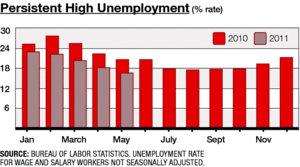For 108 years, groups representing New York City's union contractors and building trades have worked under the New York Plan for the Resolution of Jurisdictional Disputes, an agreement used to resolve inter-union disputes and bind union contractors to use organized labor. But at year-end, the era comes to a close. The Building Trades Employers Association, which represents union contractors, voted in May to let the plan expire after this year, giving members the option to use non-union workers.


It was a shot across the bow, just as the two groups were heading into the collective bargaining season. The message was clear: Something's got to give.
Building Trades Employers Association (BTEA) President Louis J. Coletti says his association's members want to remain union contractors but that the current model risks pricing them out of the market. There now is a 25% to 30% differential between union and non-union labor costs, he estimates. Some observers say the gap could be as high as 40% on smaller projects, on which union firms are less competitive.
“There should be no question in anybody's mind that this is a threshold moment in the history of the unionized construction movement in New York City, which is the strongest union market in the country. We want to preserve this business model we have, and we hope [union representatives] can help us do that at the bargaining table,” Coletti says. “Everyone must play by the same rules.”
From New York to California, tensions are running high at the bargaining table. While each market faces its own unique issues, negotiating parties share a common concern: staying competitive in a tough economy. Many union contractors struggle to land jobs in an environment in which competitors bid at minimal margins to land dwindling opportunities.
Meanwhile, unions strive to maintain members' standards of living and keep up with rapidly rising benefits costs while grappling with high unemployment. “Do we want to continue to reduce union labor and destroy the middle class?” asks Robert Ledwith, business manager of New York City Metallic Lathers' union Local 46.
Nearly five years into the construction downturn, the impact on union labor is widespread as most pacts signed during the recession are being completed by the end of 2011. Between 2000 and 2008, first-year wage-fringe hikes in settlements averaged more than 4%, according to the Construction Labor Research Council, Washington, D.C. In 2009, the average fell to 2.8%. A year later, it dropped to 1.7%, the first time since 1985 that increases fell below 2%. On average, 2010 pacts offered a first-year hike of 80¢—the first time since 1998 that number has dropped under $1. One-fourth of settlements in 2010 contained wage and fringe freezes or reductions.
Bargaining now is for a shorter term. Faced with an uncertain economy, parties are drafting agreements of one to two years, says CLRC Executive Director Carey Peters. Since 2008, 21% more pacts expire annually. In 2008, 434 contracts expired; this year, that figure will be 526. “Folks on both sides of the table are nervous about change,” he adds. “Who knows where the market is headed?”
As contract expirations come up faster, parties are experiencing bargaining fatigue. At the outset of the recession, some unions and employers showed signs of solidarity in forging new agreements. However, that sense of cooperation now is wearing thin, and many contractor groups say current talks have been the toughest in decades.
New York City, a Helluva Town
BTEA and the Building and Construction Trades Council of Greater New York (BCTC) found short-term consensus in 2009 on project labor agreements to improve pricing and help unfreeze stalled projects. But with the market still suffering, contractors continue to seek concessions, unions are fighting to hold their ground, and owners are trying new approaches—such as employing non-union firms on larger projects, not just small ones in fringe areas.
At a June 9 panel in Manhattan on labor costs sponsored by a regional economic group, Jay Badame, president and chief operating officer of Tishman Construction Corp., New York City, said the pacts have resulted in project savings of only 2% to 3%, compared with a previous pledge of 20%. “[The savings] have been totally discounted by developers,” he said. Steven Spinola, president of the Real Estate Board of New York, said that while high taxes and land costs are factors in his claim of 700 stalled projects, “organized labor has a major role in how to get us out of this.”
Coletti says a long-term solution is needed. “We here on the management side believe that this recession has created a new normal,” he says. BCTC representatives would not comment on ongoing agreements that expire on June 30 in New York City. But in a statement, Paul Fernandes, its chief of staff, said BTEA's withdrawal from the New York Plan “in no way relieves contractors of their contractual obligations to it, which are part of their collective bargaining agreements and are binding contracts with unions.”
To cut costs in New York City, employers are targeting decades-old work rules that they characterize as unproductive. Spinola claims that “non-productive work” at the World Trade Center redevelopment site in the last three years has run up costs of more than $100 million. “By reducing the amount of work rules, we could save 20% to 25% of the cost of labor on jobs,” says Ron Berger, executive director of the Subcontractors Trade Association, New York City.
Part of that strategy played out in the four-year agreement reached in late April between the Association of Master Painters & Decorators of N.Y. and the painters' union district council. Work rules and related issues in the pact include flexible start times between 6 a.m. and 9 a.m.; elimination of the hiring hall; no restrictions on work that apprentices can perform; and security background checks. A workplace performance plan also was adopted to retrain unproductive workers. After three bad evaluations, an employee can be removed from the union.
Tom Owens, spokesman for the AFL-CIO's Building and Construction Trades Dept., called the deal “groundbreaking” and expects other New York City unions will follow. “Given the state of the industry, everyone is pressured to cut costs,” he says. “Contractors recognize that our guys are more productive, and [the contractors] want to maximize productivity.”
Still, wages and benefits remain under pressure. The painters' union accepted a one-year wage freeze and 1.9% weighted average over four years; for outer-borough commercial work, it accepted a 20% cut in payroll costs toward wages and benefits. Overtime was recalculated to produce a 20% savings. The union must reduce health-care costs by 10%, or about $4.4 million, over the four-year contract. Employers also won't contribute to health benefit funds from May 2012 to May 2014, and there will be no additional employer contributions into the pension fund over the pact's term.
James Williams, general president of the International Union of Painters and Allied Trades, says the New York City deal reflects the need for union painters to find ways to increase hours and reduce unemployment. “Our New York business manager took a bold stance and made the concessions needed,” he adds.





Post a comment to this article
Report Abusive Comment